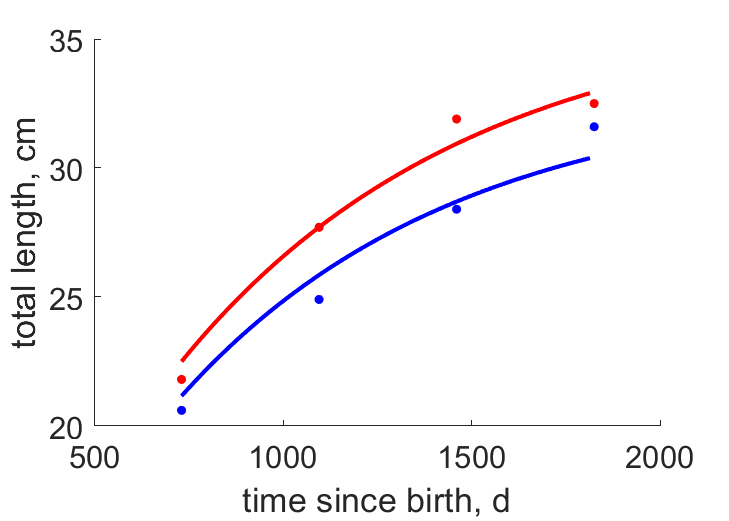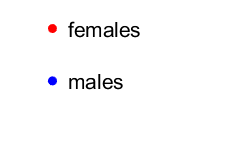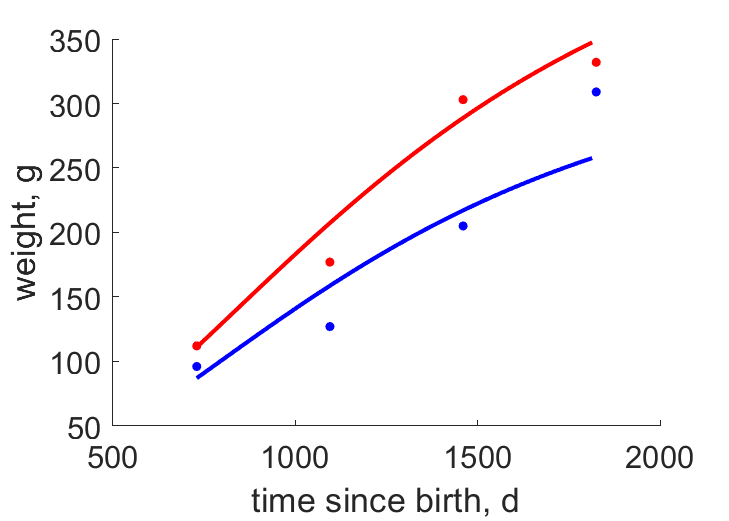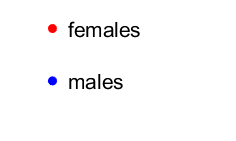Predictions & Data for this entry
| Model: abj | climate: MC | migrate: Ma | phylum: |
| COMPLETE = 2.5 | ecozone: MAc, THp | food: biPz | class: |
| MRE = 0.027 | habitat: jiMpe, piFr, 0jFr | gender: D | order: |
| SMSE = 0.001 | embryo: Fg | reprod: O | family: |
Zero-variate data
| Data | Observed | Predicted | (RE) | Unit | Description | Reference |
|---|---|---|---|---|---|---|
| am | 2920 | 2935 | (0.005166) | d | life span | fishbase |
| Lp | 38 | 35.51 | (0.06545) | cm | total length at puberty | fishbase |
| Li | 52 | 49.8 | (0.04237) | cm | ultimate total length | fishbase |
| Wwb | 0.0042 | 0.004073 | (0.03016) | g | wet weight at birth | guess |
| Wwp | 591 | 583.7 | (0.01239) | g | wet weight at puberty | fishbase |
| Wwi | 1557 | 1609 | (0.03355) | g | ultimate wet weight | fishbase |
| Ri | 854.8 | 827 | (0.03251) | #/d | maximum reprod rate | fishbase |
Uni- and bivariate data
| Data | Figure | Independent variable | Dependent variable | (RE) | Reference |
|---|---|---|---|---|---|
| tL_fm |   | time since birth | total length | (0.02336) | KuziGruz2020 |
| tW_fm |   | time since birth | weight | (0.1037) | KuziGruz2020 |
Pseudo-data at Tref = 20°C
| Data | Generalised animal | Alosa kessleri | Unit | Description |
|---|---|---|---|---|
| v | 0.02 | 0.02109 | cm/d | energy conductance |
| p_M | 18 | 250 | J/d.cm^3 | vol-spec som maint |
| k_J | 0.002 | 0.002 | 1/d | maturity maint rate coefficient |
| k | 0.3 | 0.04182 | - | maintenance ratio |
| kap | 0.8 | 0.1696 | - | allocation fraction to soma |
| kap_G | 0.8 | 0.8005 | - | growth efficiency |
| kap_R | 0.95 | 0.95 | - | reproduction efficiency |
Discussion
- Males are assumed to differ from females by {p_Am} only
Facts
- weight-length relationship: Ww in g = 0.00776*(TL in cm)^3.09 (Ref: fishbase)
- Caspian Sea from where adults ascend Volga (only few fish enter Ural and Terek) to spawn. Earlier reached upriver up to Kama and Oka system. Migration now blocked by Volgograd dam. May have formed land-lock populations in Volga reservoirs (Ref: fishbase)
Bibliography